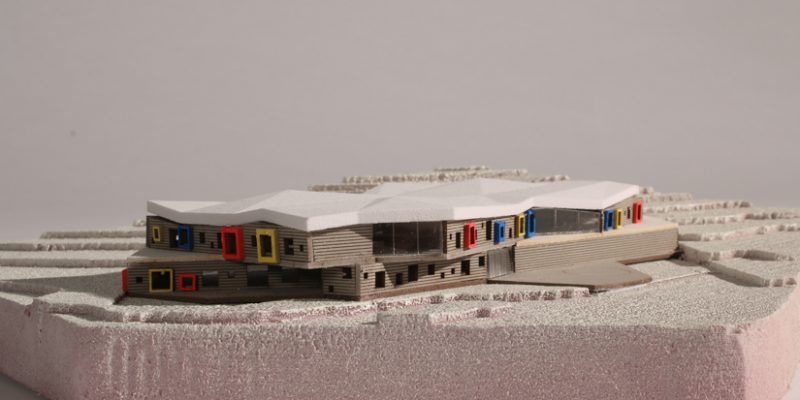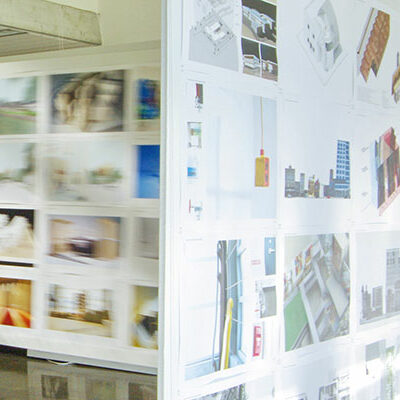The life and work of an architect is intellectually and technologically rigorous. The human brain is an architect’s most valuable tool. A powerful computer might be a close second.
Architecture students are no different from professional architects when it comes to technology. Students use the same tools and apply them in the same ways as professionals. Completing bachelor- or master’s-degree studies in the School of Architecture & Urban Planning requires the support of a robust and reliable laptop computer that is capable of producing professional-quality architectural work.
During your time at SARUP, you will develop complex 3D models. You will simulate lighting, materiality, airflow and energy flow. You will produce intricate technical drawings. You will use parametric representations to simulate intelligent, responsive envelopes and structures and interface with robotic fabrication equipment. This work requires a powerful computer. More specifically, this work requires a laptop that costs more than an iPad or lightweight PC.
Professors in the School of Architecture & Urban Planning work in private practice in addition to their teaching and research. This makes them expert sources on the computing resources that aspiring architects require. Their hardware/software recommendations for architecture students and a technology FAQ are below. These resources are intended to guide the typical BSAS, BARCH or M.ARCH student.
Before Buying, Consider Your Circumstances
We understand that individual student circumstances vary. Carefully consider your own needs and purchase the right laptop for your situation. We provide “minimum” computer/software recommendations and “preferred” alternatives whenever possible. Please note that most of the following information is provided as recommendations, not requirements. It is offered as a resource to help new and returning students make informed decisions about computer purchases. The only requirements are that sophomore students and above – including all graduate students – must have a laptop computer running the Windows 11 Pro operating system, with enough memory to run the architectural software required to complete their coursework. Whatever computer will get a student to this result is an acceptable computer.
Undergraduates have minimal computer requirements in the freshman year. They write papers, take notes, collaborate online, and so forth, but they do not yet need architecture-specific software. Freshmen can use a MacBook, hand-me-down laptop, or even an old desktop computer in many cases during freshman year. Once students reach the sophomore year, they begin design studio courses and other technical courses that have heavy computer requirements. The discussion of hardware and software provided here applies to students from the sophomore year onward, and graduate students.
- “Minimum” means that this purchase is critically important for successfully completing coursework.
- “Preferred” means that this purchase costs more than the “minimum” alternative and may offer a better-quality student experience.
Computer Hardware Requirements
| REQUIRED COMPUTER TYPE: LAPTOP | |
| Students participate digitally in various learning environments on and off campus. Laptops are mobile and versatile, traveling easily from lecture hall to design studio. They are able to measure and document items during site work, and they support and store student work at home or in design studio. A laptop is required hardware for students beginning in the sophomore year, and for all graduate students. | |
| REQUIRED OPERATING SYSTEM: MICROSOFT WINDOWS 11 PRO, 64-BIT | |
| The Windows 11 Pro operating systems is the standard platform in professional architectural practice and in the School of Architecture & Urban Planning. Most of the software students use in their classes runs only on Windows, not on Mac OS. While it might be possible to run some of these tools on a Mac using virtual Windows, students have reported technical difficulties when attempting to do so. Windows 11 Pro is required because it matches the typical architecture firm’s office environment, and because it is a more robust system that is designed to handle the advanced, complex computational processes performed by architectural software. Students have also reported many technical difficulties when attempting to run architectural software on certain Windows tablets setups like Surface Pros. | |
| HARD DRIVE TYPE: SDD (Solid State Drive) | |
| Minimum: | 500 GB SSD drive |
| Preferred: | 1 TB SSD drive, or larger |
| MEMORY/RAM | |
| Minimum: | 16 GB |
| Preferred: | 32 GB or more |
| VIDEO CARD: should be discrete not shared | |
| For an extended discussion of video cards for architectural design and rendering, visit the Lumion blog, and review the Department of Architecture software suite below. | |
| Minimum: | Nvidia or AMD, 8 GB memory, discrete not shared or integrated |
| Preferred: | Nvidia Quadro or GeForce RTX or AMD Radeon, 16 GB memory or higher |
| SCREEN SIZE | |
| Computer-aided design is a graphical medium and screen size and resolution are important considerations. | |
| Minimum: | 15” with minimum resolution of 1920×1080 |
| Preferred: | 17” screen is nice for graphics, but heavier |
| MOUSE | |
| A mouse is essential for using 3D modeling and graphics software. | |
| Minimum: | External optical mouse |
| NETWORKING | Minimum: | Wireless |
| WARRANTY | |
| An on-site warranty means that the company will send someone to your home or to a campus drop-off location to fix your computer. Mail-in service normally takes two-plus weeks. | |
| Recommended: | Four-year on-site/at-home warranty with accidental damage service to protect against drops and spills. |
Architecture Software Suite
The Department of Architecture requires a basic software suite for all students. Some required software must be purchased; some can be acquired for free, as indicated below. Please obtain the current production version of all software.
As students advance in the architecture program, specialized software will be required by particular teachers in particular courses. The list below includes only the basic software suite, not course-specific software.
Microsoft Office Suite is required for first-year (freshmen) students and beyond. All other software is required for sophomore year and beyond. For M.ARCH students, the architecture software suite is required for the duration of the program.
| Software Package | Cost |
|
When you first get your laptop, you are not required to install all software packages listed here. You should install the software based your course curriculum or degree path that your pursuing. Look for the notes on BSAS and M.Arch to determine when software may be required.
BSAS is Bachelor of Science, Architectural Studies |
|
| MICROSOFT OFFICE SUITE | Free |
| Includes Microsoft Word, PowerPoint and Excel. Download the software at: https://uwm.edu/o365/proplus/ How to install Office 365 at https://kb.uwm.edu/page.php?id=45766 BSAS: Required for freshmen level and above. |
|
| GOOGLE EARTH PRO | Free |
|
Obtain at https://www.google.com/earth/ BSAS: Required for freshmen level and above. |
|
| ADOBE CREATIVE CLOUD STUDENT EDITION | $20/month first year, then $30/month |
|
Adobe Creative Cloud is subscription based that includes Photoshop, Illustrator, InDesign, Acrobat Pro and other Adobe products. Subscribe through Adobe’s website. All Adobe products are included with the subscription. BSAS: Required for sophomore level and above. |
|
| RHINOCEROS | $195 one-time purchase |
|
Go to the Rhinoceros website at www.rhino3d.com/edu. This is a general-purpose modeling system for architectural designers and is used in virtually every single studio course in the architecture curriculum. BSAS: Required for sophomore level and above. |
|
| Autodesk | Free |
|
Visit the Autodesk Education webpage (and look for the “Sign In” link). Fill out the registration form using your uwm.edu email address. When creating a password, please use a different one than your UWM password. After logging in, go to the software download section to obtain the free software. Autodesk needs to verify your eligibility for the free software by requesting a copy of your UWM Photo ID. BSAS: Needed for sophomore level and above. |
|
| Preferred: | AutoCAD |
| Preferred: | Revit |
| Optional: | AutoCAD Architectural |
| Optional: | 3DS MAX |
| Optional: | Maya |
| Optional: | CFD |
| Rendering and Animation Engines | Cost | |
|
Rendering and Animation engines are the most processor- and graphics processor-intensive applications for your devices. You want to have access to one or more of these rendering packages available on your device to complete your course work. BSAS: Required for sophomore level and above. |
||
| Preferred: | Lumion | Free |
| This is an advanced rendering and animation engine. Please note that is the most processor- and graphics processor-intensive software listed here, visit the Lumion blog for hardware requirements. Lumion outputs in photo, movie or panorama mode. Obtain Lumion at https://lumion.com/students.html. | ||
| Optional: | Twinmotion | Free |
| Twinmotion output photos, panoramas, and standard Video or 360° VR videos. Twinmotion combines an intuitive icon-driven interface with the power of Unreal Gaming Engine. Obtain Twinmotion at: https://www.unrealengine.com/en-US/twinmotion | ||
| Optional: | Enscape | Free |
| Enscape output photos, panoramas, videos, standalone, and cloud sharing. Enscape is VR capable with many VR headsets. Enscape works with Revit. Rhino, and Sketchup. Obtain Student Version of Enscape at: https://enscape3d.com/educational-license/ | ||
| Optional: | V-Ray | $99/year |
| This is a general-purpose rendering engine. Students who use a free version of Lumion (see above) do not need to purchase V-Ray. Obtain a student version of this Rhinoceros plug-in at https://vray.us/academic. | ||
Frequently Asked Questions
An another tutorial option is LINKEDIN LEARNING which is free to all UWM students and is available at https://uwm.edu/technology/linkedin-learning/


